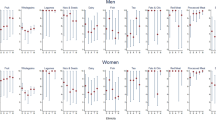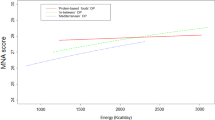Abstract
Background/Objectives:
To investigate the influence of social and physical factors on diet quality in materially deprived (low income) older people in the United Kingdom.
Subjects/Methods:
A diet quality index was obtained for 222 men and 440 women aged 65 and over living alone or with other adults of retirement age from the United Kingdom Low Income Diet and Nutrition Survey (2003–2005). The association between diet quality and social and physical factors was investigated by logistic regression analysis.
Results:
Analysis revealed several barriers to an adequate diet in the older low-income population. For both men and women, having the best quality diet was inversely associated with usually eating meals on one's lap as opposed to at the table (Adjusted odds ratio (ORs)=0.3, 95% confidence interval: 0.12–0.77 (men), 0.3, 0.17–0.56 (women)). For men, difficulty chewing was inversely associated with the best quality diet (OR=0.4; 0.13–0.99), whereas for women, current smoking and being 75 years or over were inversely associated with the best quality diet (OR=0.2; 0.06–0.42 and 0.5; 0.27–0.87, respectively); P value for all associations was <0.05.
Conclusions:
Results suggest that the social setting is an important determinant of diet quality in this group and future studies should collect details on where and with whom meals are taken to fully investigate the extent of this influence.
This is a preview of subscription content, access via your institution
Access options
Subscribe to this journal
Receive 12 print issues and online access
$259.00 per year
only $21.58 per issue
Buy this article
- Purchase on Springer Link
- Instant access to full article PDF
Prices may be subject to local taxes which are calculated during checkout
Similar content being viewed by others
References
Age Concern England and National Consumer Council (2006). Fit as Butcher's Dogs? A Report on Healthy Lifestyle Choice and Older People. Age Concern: London.
Australian Institute of Health and Welfare (2007). Australian Diet Quality Project. Australian Institute of Health and Welfare: Canberra.
Bernstein MA, Tucker KL, Ryan ND, O’Neil EF, Clements KM, Nelson ME et al. (2002). Higher dietary variety is associated with better nutritional status in frail elderly people. J Am Diet Assoc 102, 1096–1104.
Blane D, Abraham L, Gunnell D, Maynard M, Ness A (2003). Background influences on dietary choice in early old age. J R Soc Promot Health 123 (Suppl 4), 204–209.
Caroline Walker Trust (2004). Eating Well for Older People. Practical and Nutritional Guidelines for Food in Residential and Nursing Homes and for Community Meals, 2nd edn. CWT: Herts.
Department of Health (1997). At Least Five a Day: Strategies to Increase Vegetable and Fruit Consumption. TSO: London.
Donkin AJW, Johnson AE, Lilley JM, Morgan K, Neale RJ, Page RM et al. (1998). Gender and living alone as determinants of fruit and vegetable consumption among elderly living at home in Nottingham. Appetite 30, 39–51.
Dubois L, Girard M, Bergeron N (2000). The choice of diet quality indicator to evaluate the nutritional health of populations. Public Health Nutr 3, 357–365.
European Nutrition for Health Alliance (2006). Malnutrition among Older People in the Community: Policy Recommendations for Change. European Nutrition for Health Alliance: London.
Foote JA, Murphy SP, Wilkens LR, Basiotis PP, Carlson A (2004). Dietary variety increases the probability of nutrient adequacy among adults. J Nutr 134, 1779–1785.
Holmes B, Roberts C, Nelson M (2008). How access, isolation and other factors may influence food consumption and nutrient intake in materially deprived older men in the UK. Nutrition Bulletin 33, 212–220.
Howarth G (1993). Food consumption, social roles and personal identity. In: S Arber and M Evandrou (eds). Ageing, Independence and Life. Jessica Kingsley: London.
Johnson A, Donkin AJ, Morgan K, Neale RJ, Page RM, Silburn RL (1998). Fruit and vegetable consumption in later life. Age Ageing 27, 723–728.
Jones C, Dewar B, Donaldson C (2005). Recipe For Life: Helping Older People Eat Well. Queen Margaret University College: Edinburgh.
Locker D (1992). The burden of oral disorder in a population of older adults. Community Dent Health 9, 109–124.
Marshall TA, Warren JJ, Hand JS, Xie XJ, Stumbo PJ (2002). Oral health, nutrient intake and dietary quality in the very old. J Am Dent Assoc 133, 1369–1379.
McAlpine SJ, Harper J, McMurdo ME, Bolton-Smith C, Hetherington MM (2003). Nutritional supplementation in older adults: pleasantness, preference and selection of sipfeeds. Br J Health Psychol 8, 57–66.
McKie L, MacInnes A, Hendry J, Donald S, Peace H (2000). The food consumption patterns and perceptions of dietary advice of older people. J Hum Nutr Diet 13, 173–183.
Moshfegh AJ, Borrud LG, Perloff BP, LaComb RP (1999). Improved method for the 24-h dietary recall for use in national surveys [abstract]. FASEB J 13, A603.
Nelson M, Erens B, Bates B, Church S, Boshier T (2007). Low Income Diet and Nutrition Survey. TSO: London; available at http://www.food.gov.uk.
Nelson M, Dick K, Holmes B, Thomas R, Dowler E (2003). Low Income Diet Methods Study. Food Standards Agency: London.
Office of National Statistics (2008). Mid-year population estimates. http://www.statistics.gov.uk/cci/nugget.asp?ID=949.
Patterson RE, Haines PS, Popkin BM (1994). Diet quality index: capturing a multi-dimensional behaviour. J Am Diet Assoc 94, 57–64.
SPSS Inc (2006). SPSS for Windows: Release 15.0. SPSS Inc: Chicago, Illinois.
StataCorp (2007). Stata Statistical Software: Release 9. Stata Corporation: College Station, Texas.
Whetstone M (2002). Hard Times - A Study of Pensioner Poverty. Centre for Policy on Ageing: London.
Acknowledgements
LIDNS was funded by the Food Standards Agency. The present analysis and manuscript was funded by additional monies obtained from the WRVS. The authors gratefully acknowledge WRVS for funding the secondary analysis and Dr Lisa Wilson from the Caroline Walker Trust for her comments. LIDNS was carried out by the National Centre for Social Research, King's College London, and the Royal Free and University College London Medical School.
Author information
Authors and Affiliations
Corresponding author
Ethics declarations
Competing interests
The authors declare no conflict of interest.
Additional information
Contributors: BH and CR were involved in all stages of LIDNS, carried out the analyses and prepared the manuscript.
Rights and permissions
About this article
Cite this article
Holmes, B., Roberts, C. Diet quality and the influence of social and physical factors on food consumption and nutrient intake in materially deprived older people. Eur J Clin Nutr 65, 538–545 (2011). https://doi.org/10.1038/ejcn.2010.293
Received:
Revised:
Accepted:
Published:
Issue Date:
DOI: https://doi.org/10.1038/ejcn.2010.293
Keywords
This article is cited by
-
Culinary Nutrition Education Programs in Community-Dwelling Older Adults: A Scoping Review
The Journal of nutrition, health and aging (2023)
-
Social engagement pattern, health behaviors and subjective well-being of older adults: an international perspective using WHO-SAGE survey data
BMC Public Health (2020)
-
Factors Influencing Food Choices Among Older Adults in the Rural Western USA
Journal of Community Health (2017)
-
“Eating together” is associated with food behaviors and demographic factors of older Japanese people who live alone
The Journal of nutrition, health and aging (2017)
-
Individual and collective factors predicting change in diet quality over 3 years in a subset of older men and women from the NuAge cohort
European Journal of Nutrition (2016)



